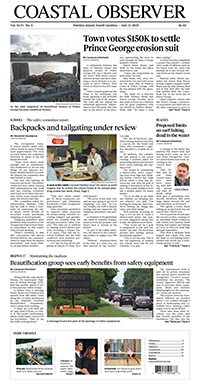Beaches
State argues for dismissal of suits over Pawleys renourishment

Suits by property owners at Prince George claiming they were damaged by the effects of a beach renourishment project at Pawleys Island should be dismissed because none of them appealed the state permit for the work, an attorney for the state argued in court last week.
An attorney for two of the owners said that argument was flawed because the state didn’t provide proper notice of the permit application.
The virtual hearing before Circuit Court Judge Paul Burch was the first time the arguments had been aired since Bud and Melesa Watts filed suit last May against two state agencies, the town and its contractors saying that the renourishment project caused Pawleys Creek to migrate along the beach in front of their oceanfront property in Prince George.
At the time, Pawleys Inlet had moved 300 feet. “The situation has become much worse,” Merritt Abney, the couple’s attorney, said. “My clients have lost property forever to the ocean.”
Following the Wattses suit, another group of Prince George owners filed a similar suit. The Prince George Community Association filed suit in January, saying the erosion threatens its property as well as that of its members.
The town completed the $14.8 million project in March 2020. It obtained a permit from the state Department of Health and Environmental Control to put 1.1 million cubic yards of offshore sand on the beach from the south end parking lot to north of First Street. The Department of Parks, Recreation and Tourism helped fund the project. It was designed by Coastal Science and Engineering and carried out by Marinex Construction. All were named in the suits.
All the plaintiffs cited a 2010 study prepared by Coastal Science for the Prince George association that proposed ways to mitigate the migration of Pawleys Inlet due to beach renourishment. The study was commissioned after Georgetown County proposed building a groin to trap sand in front of the south end parking lot.
The suits say that DHEC failed to require the town to mitigate for the impact of its renourishment project on adjacent property owners as required by its own regulations. The erosion was no surprise to the defendants, Abney said. “No plan was put in place.”
PRT moved to dismiss all three suits, saying that it is not a proper party to the suits because it only provided funding, but also citing the failure of any of the plaintiffs to challenge the permit.
“None of the plaintiffs participated in the permitting process,” Walker Humphrey, attorney for PRT, told the court. “We wouldn’t be here if DHEC didn’t issue the permit.”
The law provides for appeals of permits first to the DHEC board and then to the Administrative Law Court. That court’s decisions can be appealed to the state Court of Appeals.
“Each of the plaintiffs had a full and fair opportunity to be involved in the process,” Humphrey said. “They could have avoided the harm” that they claim resulted.
Since there was no challenge, the permit was deemed to be proper and PRT funded a portion of the project, fulfilling a mandate included in budget provisos adopted by the General Assembly, he said.
The suits are “a collateral attack” on the permit, Humphrey said, and allowing them to go forward “would substantially frustrate the permit process.”
Abney, who argued for all the plaintiffs on their common issues, said “the Wattses received no notice of the application to DHEC at any time.” The administrative remedy outlined by Humphrey, “was not available to the Wattses.”
He also argued that PRT is a proper party to the suits because it helped fund a project that caused harm. The plaintiffs have all asked the court for an injunction requiring that Pawleys Inlet be restored to its location before the renourishment. PRT could help fund that without a mandate in the legislature since it would be correcting a mistake, Abney said, and would “complete the project in the manner it should have been done in the first place.”
Humphrey disputed the claim that the property owners were entitled to receive “direct notice” rather than notice by publication. “If they didn’t pick up the newspaper on those days, that doesn’t allow them to avoid that administrative process,” he said.
But if they believe DHEC failed to follow the notice requirement, Humphrey said the solution would be for them to file those administrative appeals now.
“This case should not be pending in Circuit Court,” he said.
The judge asked both attorneys to prepare proposed orders. “I may have to take them both and come up with something,” Burch said.
He also heard a request from Abney to require the town of Pawleys Island to be more specific in its response to a request for documents related to the renourishment. Abney said he asked for all communications about the project and only received emails included in the in-box of the former administrator, Ryan Fabbri. But the town identified others who were involved in the project.
“We gave him everything that we had, that the town had,” said Mark Buyck III, the attorney representing the town. “He was given a scad of emails.”
“They’ve searched one person’s inbox,” Abney said.
The judge told the attorneys to reach an agreement.
“As long as y’all have been around, you can get together and come up with something that will work,” Burch said.




